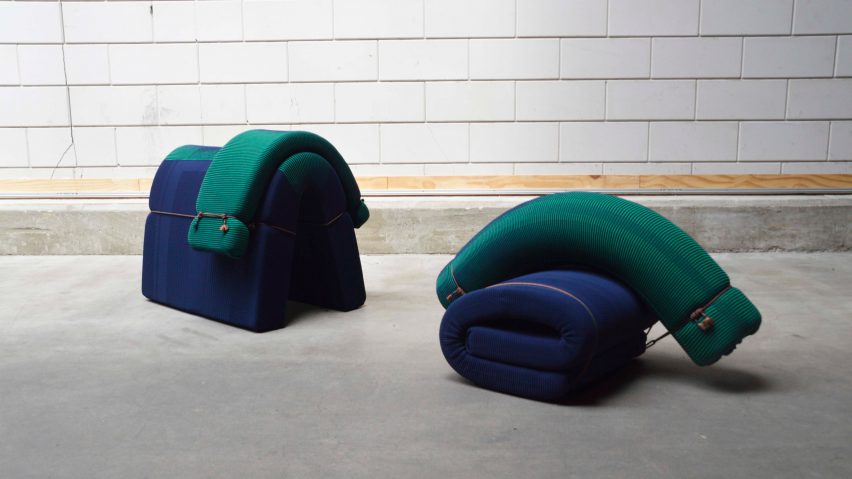Design Academy Eindhoven graduate Floor Skrabanja has created a collection of seats made from a single piece of 3D-knitted upholstery that needs no gluing or stitching, so can easily be deconstructed.
The series features a chair, stool and bench, each covered with a seamless, continuous piece of fabric that is slipped on like a sleeve and bound to the frame with a contrasting orange cord.
The upholstery fabric is 3D-knitted – a fabrication method which combines digital pattern-making with the knitting process. The process replicates 3D printing's ability to scale and multiply a pattern, in order to create complex designs at specified sizes.
The knitted yarns that make up the fabric can be unraveled in order for the threads to be re-knitted as another piece of furniture in future.
"Like with 3D printing, you code a shape on the computer and then you can reproduce it endlessly," Skrabanja told Dezeen.
"The difference is that a 3D printing filament is heated and will melt together so you get a solid shape composed of layers. With 3D knitting you bond with the yarn."
"The traditional limitations of knitting are challenged by the new technology," she continued. "Textiles are mostly used and made in two-dimensional surfaces, but with this knitting technique you can rethink textiles as a three-dimensional shape."
The technique can be scaled up to cover entire furniture pieces, as well as to make clothes or blankets.
The designer worked with the knitting experts at the Textile Museum in Tilburg to finesse the myriad of variables that can affect a knitted piece – ranging from the type of thread used, to the tension with which it is bound.
The code must be recalculated every time a new material is introduced, using trial and error.
"Unlike 3D printing, the material influences the shape and feel of the outcome," she explained. "Every yarn acts differently, depending on the twine elasticity and so on."
The seats themselves consist of floppy shapes that are variously folded in on themselves or draped over each other, propped up by an aluminium frame filled with fibres shredded from old textiles.
This, Skrabanja explained, is how most discarded fabric ends up – shredded or pulled apart to become stuffing for mattresses, insulation or, in this case, upholstery.
She believes that knitted fabric presents a unique opportunity in moving towards a more circular furniture design, because it lends itself to being disassembled and reused without compromising the quality of the original material.
"Products and especially textile products are not consciously designed with the thought of how we can use the materials again after the life of the product," she explained.
"There is an excess of textiles. I would say enough have been produced already," she continued. "That's why I envision my pieces being collected, the textile unraveled, cleaned, re-spun and sold as a yarn."
"If you have ever unraveled a knit, or watched your jumper come apart, you know how easy it would be to pull on a single thread on a seamless shape and be left with a pliable high quality yarn."
Finding the right yarn was key, as it needed to be durable enough to be endlessly reused.
That meant mixing yarns like polyester and cotton was out of the question as this makes the textile harder to recycle, while wool would break too easily.
"Considering the need for durability in a frequently-used furniture piece, I settled on a texturised polyester yarn," said the designer. "In the future I would love to use recycled yarns but at the moment the quality of these isn't high enough."
In the past, 3D-knitting has mainly been used in furniture design to create seats for chairs – as in Benjamin Hubert's Tent and IKEA's PS 2017 – rather than covering an entire piece of furniture.

